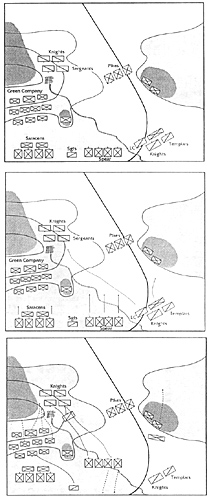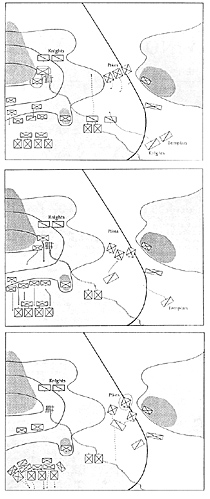 During the Middle Ages the "Holy Roman Empire" included the Italian city-states, who were usually allied-with the Pope. In the course of this struggle, city-states rose up against Imperial authority, Imperial armies crossed the Alps to put
down rebellion, Popes excommunicated Emperors, Emperors marched into Rome
to settle disputed Papal elections, and every so often everyone went off on
Crusades. The battle of "Vino Rosso" was a fictional action typical of this period,
fought in January 1991 by the Mayfair Gamers of Chicago using DEUS VULT rules.
During the Middle Ages the "Holy Roman Empire" included the Italian city-states, who were usually allied-with the Pope. In the course of this struggle, city-states rose up against Imperial authority, Imperial armies crossed the Alps to put
down rebellion, Popes excommunicated Emperors, Emperors marched into Rome
to settle disputed Papal elections, and every so often everyone went off on
Crusades. The battle of "Vino Rosso" was a fictional action typical of this period,
fought in January 1991 by the Mayfair Gamers of Chicago using DEUS VULT rules.
This particular battle occurred after Emperor Friedrich der Grosse ("Fat Freddy") got in trouble with the Pope, who ordered him to go on Crusade to the Holy Land. Of course, the Emperor needed extra money for the expenses of the Crusade, so he declared a special tax assessment. There was general objection to this, and the thrifty burghers of Prosciutto del Parma went so far as to take up arms with the war-cry of "No new taxes!" Soon Fat Freddy was on the march to deal with this insolence.
The Imperial army consisted of about 7,600 men (380 figures in game scale). 3,800 were German feudal levies: 400 mounted knights, 240 sergeants (mounted men-at-arms), 160 light cavalry, 2,000 spearmen, and 1,000 crossbowmen. 3,600 were Saracen infantry drawn from the Emperor's dominions in Sicily, 2,400 spearmen and 1,200 archers. (Why are Saracens helping a would- be Crusader? They're from Sicily. They don't care what he does in Palestine, as long as they get paid.). Also present was a detachment of 240 Templar knights, in return for Fat Freddy's promised assistance in the Order's next campaign in the Holy land.
The Prosciuffese army was about 5,000 men (250 figures). The city militia included 240 mounted knights, 240 sergeants, 1,600 pikemen, and 600 crossbowmen. The rest of the army was the "Green Company" of mercenaries (a box of 120 generic medieval infantry figures, all in green trim, which I use to fill out any shorthanded army). The Green Company had 900 swordsmen, axemen, and halberdiers, 600 crossbowmen, 500 bowmen, and 400 whatsitmen (20 figures with clubs, spears, bows, swords, slings, and one warhammer).
Map 1 shows the terrain and the initial setup. The Prosciuffese army was deployed in a blocking position around the village of "Vino Rosso", at a gap in a mountain barrier that Fat Freddy would have to come through. Wooded ridges descend on both sides to a narrow gap. The village is partway up the west side, near a spring from which a stream runs out into the plain to the south. The west ridge is bare and passable to well past the village, while the end of the east ridge is heavily wooded.
The pikemen were drawn up across the bottom of the gap, with crossbowmen on the left flank, and the cavalry to the right rear, behind the village. The knights were-all the way at the back slope of the ridge, where they couldn't see the enemy. The Green Company was on the right, defending the ridge past the village. On this steep slope they were formed in three lines of baffle, with the whatsitmen holding an outlying wooded knoll, and the bowmen in reserve on the ridge top.
"Fat Freddy" sent his Saracen mercenaries against the Greens on the left, supported by the German sergeants. The spearmen were in the center, and the remaining cavalry were on the right with a screen of crossbowmen in front.
The Saracens engaged first, exchanging arrows with the Green crossbowmen. The light-armored Saracens took heavier losses, but the front rank units of the Greens were heavily chewed up too. Then the German sergeants charged in and annihilated a halberdier unit in the center of the front rank. This triggered morale checks for the rest of the Green units. "Sir John Hawkflem" (commanding the Greens) now displayed a remarkable gift for rolling 90 or better on percentile dice, causing four additional units to rout. Fortunately for the Greens, the sergeants were badly disordered from their charge and melee. While they were reforming the remaining crossbowmen riddled them, and then a unit of halberdiers closed in for the coup-de-grace. Some of the routed troops were rallied in the meantime.
"Sir John" now had his remaining melee troops charge off the ridge into the thick of the Saracens. Some hard-fought melees ensued, but finally superior Green armor and troop quality overcame Saracen numbers, and the Islamic hirelings were driven off the field. This was just in time, as Green losses were approaching 25%, and "Sir John" had secret instructions to pull his men out of the battle if their losses reached that level.
Losses of "whatsitmen" did not count toward this. Ironically, despite their exposed position the whatsitmen took no losses.
 In the center, the Imperial spearmen rumbled forward, while the light
cavalry ranged far ahead in search of the Prosciuttese cavalry. The
Imperial crossbowmen also pushed forward, driving back the
Prosciuttese left-wing archers. "Fat Freddy" kept his knights and the
Templars back in reserve. The light cavalry located the Prosciuttese
cavalry up behind "Vino Rosso". The Prosciuttese sergeants immediately
rode them down, and continued onto engage the Imperial spearmen on
the plain below, charging three spear units. One held firm, impaling
many of the charging horsemen, but two broke and fled.
In the center, the Imperial spearmen rumbled forward, while the light
cavalry ranged far ahead in search of the Prosciuttese cavalry. The
Imperial crossbowmen also pushed forward, driving back the
Prosciuttese left-wing archers. "Fat Freddy" kept his knights and the
Templars back in reserve. The light cavalry located the Prosciuttese
cavalry up behind "Vino Rosso". The Prosciuttese sergeants immediately
rode them down, and continued onto engage the Imperial spearmen on
the plain below, charging three spear units. One held firm, impaling
many of the charging horsemen, but two broke and fled.
"Fat Freddy" now committed his knights to prevent the collapse ot nis center. The remaining Prosciuttese sergeants were quickly crushed. However, this victory intoxicated the arrogant Ritters: they failed their Control Test. As knights often will, they rushed forward unsupported, leaving the infantry behind. The knights attacked the nearest visible enemy: the Prosciuttese pikemen, who had advanced out from the pass. This was not a good idea. The pikemen didn't flinch from the charge. Many a knight was skewered in the saddle before getting into sword's reach of the enemy.Even so, the knights had a massive initial impact, and drove back the leading block of pikemen. However, the rest of the pikes came up, and with heavy losses the knights broke and fled. The surviving Imperial infantry followed their social betters off the field, and the tax resistance was victorious.
The Prosciuttese losses were minor: the sergeants were destroyed, some pikemen and left-flank archers lost, and the Green Company chewed up. The Imperial army lost their entire Saracen wing, half their spearmen, and all their cavalry except the Templars.
The Templars, incidentally, managed for once to keep their heads, and stayed out of the attack on the pikemen. In spite of their intrinsically inferior control rating and annoying missile attacks, they stayed under control by one pip on a percentile dice roll.
For those of you who enjoy such medieval thud and blunder, the DEUS VULT rules will be published later this year this year by the Emperor's Press.
Back to Table of Contents -- Courier #56
To Courier List of Issues
To MagWeb Master Magazine List
© Copyright 1991 by The Courier Publishing Company.
This article appears in MagWeb (Magazine Web) on the Internet World Wide Web.
Other articles from military history and related magazines are available at http://www.magweb.com